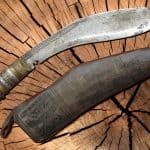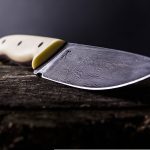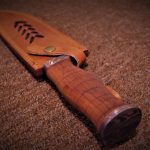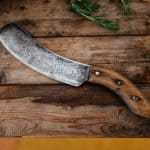
Introduction
Using a leather strop to sharpen a knife is an easy and effective way to keep your knives in good shape without cumbersome sharpening equipment. Leather strops, also known as honing strops, provide a smooth surface, which helps to sharpen the blade quickly and efficiently. The process of using a leather strop to sharpen your knives can be done at home with minimal effort and cost.
Instructions:
1. Start by cleaning your knife with warm soapy water or with a damp cloth before using the leather strop. Ensure that all debris is removed from the blade as it can affect the sharpening process.
2. Attach the base of your leather strop to a flat surface, such as a countertop or table top. Commonly used materials for creating a secure base include double-sided tape or hooks attached into studs in the wall/ceiling.
3. Place the edge of your knife onto the leather strop–ensuring even pressure applied alongside both sides of the knife throughout this entire process will help yield best results–and run it along its length from heel to tip for 10-20 strokes depending on how dull your blade is. Make sure you hold pressure against both sides and do not apply too much pressure as it can damage the blade’s edge over time
4. For optimal sharpness, use a slightly different technique by rotating the angle of your blade against the leather strop each time you drag it across, making sure that you switch up direction every couple of passes. This helps ensure that both sides of the blade get sharped evenly and thoroughly. Doing this motion lightly several times will improve its effectiveness substantially!
5 .once finished use an extra light pass over each side one time just for precaution but make sure there is no undue force when running these last strokes across it; otherwise, you could damage your knife or shorten its life span significantly!
6 After using your leather strop regularly you may want to apply some wax or lubricant onto it periodically (monthly), depending on how much usage gets done in order maintain its structure and effectiveness over time as well as preventing any dirt/dust that may accumulate while idle which can limit proper honing quality after usage
Conclusion:
Sharpening a knife with a leather strop is quick and effective method to keep blades sharp without having access to professional equipment. With patience, even beginning users should soon learn how to use their leather strops correctly and efficiently – yielding pristine results!
Types of Leather Strops and How to Choose the Right One
When it comes to sharpening knives, leather strops are a fantastic tool. Not only are they incredibly versatile and easy to use, but they’re also quite affordable, making them a great option for those who don’t have access to more advanced sharpening equipment.
Leather strops come in a few different varieties – the most popular being smooth leather and treated leather. Smooth leather strokes are great for removing burrs and polishing a blade without adding additional grit or texture. Treated leather strops, on the other hand, often have some sort of abrasive compound applied to them which provides better results when fixing duller blades as opposed to finishing off pleasantly sharp ones.
When it comes to deciding on which type is right for you, consider the type of tasks your knives are likely to perform and how frequently you’ll be needing them sharpened. If you mostly do light cutting tasks around the kitchen or yard such as slicing vegetables or cutting wires then a smooth leather strop should work perfectly fine for you; if however you need heavier duty tools with much sharper edges for knife fighting or carving through tough objects, then a treated strop will give you better results.
To use your chosen strop on a knife: start by placing one end of the strop in either hand (depending on what feels comfortable). Then with even pressure draw your blade across the length of the strop several times with an angle of about 20-25 degrees. This action removes any burrs left behind during honing/sharpening and helps further refine your edge. It’s important that you use steady pressure while doing this step as any aggressive movement can potentially damage the leather surface while less effort will yield suboptimal results.
After that simply repeat until your desired degree of sharpness is achieved – simple as that!
How To Care For and Store Your Leather Strop
Before you begin sharpening your knife, there are some important steps necessary to properly care for and store your leather strop. First, it’s important to keep the surface of the strop smooth and free from damage. This can be accomplished by regularly conditioning the leather with either mink oil or a high-end leather conditioner. The more conditioned the leather is, the easier it will be to move the knife back and forth along its surface.
Once conditioned, make sure that your strop is free from any dirt or dust particles before beginning your sharpening session. Additionally, always ensure that you have ample space around you in order to avoid any potential accidently cuts caused by slipping while stropping. Finally, when storing your strop always ensure that it’s kept in an upright position or hung on a wall so as to not compress any part of the leather if stored away in a box or bag for extended periods of time.
The Best Technique For Sharpening a Knife with a Leather Strop
1. Start by cleaning the blade of your knife with a detergent and warm water; this will remove any dirt, grime, and oil that may be present.
2. Once it’s clean and dry, you’ll need to make sure the edge is flat and even; this can be done using a sharpening stone or a honing rod.
3. Place the strop vertically on a flat surface such as a table or countertop. Make sure that it’s secure and won’t move during sharpening.
4. Take your knife in one hand and gently begin rubbing the blade against the grain of the leather in a back-and-forth motion; apply even light pressure for maximum results. This should remove any small imperfections or roughness from the edge of your knife and will ensure a smoother cut when you are slicing food or materials.
5. Be careful not to apply too much pressure or press too hard against the leather strop; doing so could damage both your blade and strop over time.
6. To take your sharpening to the next level, try applying some honing compound to your strop before beginning – this will help buff out any imperfections while ensuring an extra-sharp edge on your blade after each use!
7. After several passes with medium pressure, you should now have an extremely sharp edge ready to go! Give yourself a pat on the back – you just successfully used a leather strop to sharpen your own knife!
Tips and Tricks for Sharpening with a Leather Strop
1. Identify the grit of the strop you have: Make sure that you know how coarse or fine the leather strop is before proceeding, as this will affect how you sharpen your knife. You can typically identify a strop’s grit by its color; lighter colored strops tend to be finer while darker colored ones are coarser.
2. Preparing the knife: Prior to sharpening, make sure that your knife is properly cleaned with hot water and soap, then dried thoroughly. This will help ensure that the leather doesn’t become damaged through exposure to oils or moisture retained on the blade prior to sharpening.
3. Begin stropping: Place your strop on a solid surface such as a table or countertop, and start running your blade along it in consistent back-and-forth strokes using medium pressure (be sure not to push too hard – you don’t want to damage either the leather or the blade). As opposed to honing a knife, you should be primarily focusing on maintaining an angle of 15-20 degrees here during each stroke. Don’t forget to also switch directions periodically!
4. Maintain high quality sharpening: Stropping should only take a few minutes at most before complete sharpness has been restored; remember that going too coarse could cause nicks and blemishes on the edge of the blade which are very difficult to repair without specialist tools and know-how so it’s best not to press too hard when stropping your knives. For extra sharpness, some edges may need light honing afterwards (using similar techniques discussed earlier but with even higher levels of concentration). Additionally, make sure that both sides of the blade get equal attention when stropping if you want them both as sharp as possible for use!
Pros & Cons of Using a Leather Strop to Sharpen a Knife
Pros:
1. It is easy to use, meaning that the user does not require any special skills or expertise to sharpen their blade.
2. Leather strops act as a final finishing step on already sharpened knives, giving them an incredibly fine edge and making them more efficient for cutting.
3. Since leather strops do not require additional tools or fluids such as oils and water, it is easier to clean and maintain compared to other methods of sharpening a knife.
4. Leather strops are affordable and can usually be found at most hardware stores.
Cons:
1. For the best results, the user should have a good eye for sharpening angles when using a leather strop as incorrect angles can damage the knife’s edge instead of improving it.
2. The process may take some time if the user wants to achieve optimal results with their blades since they will need to switch between pulling strokes as well as circular motions while using a leather strop – which could become tedious over time if done too often with the same blade.
3. The texture of leather can cause tiny particles from carbide blades that transfer onto it over time, which can affect its performance and durability in turn if shoes
Conclusion
A leather strop can be an effective way to sharpen a knife. Before starting, make sure to use a protective barrier while sharpening, such as a cutting board, to protect the blade and the sharpening surface alike. Additionally, take precautionary steps such as applying adequate pressure and moving your knife evenly across the strop for best results. Some other tips for using a leather strop successfully:
– Use plenty of stropping compound to ensure better honing of the blade and help build up an edge on the knife.
– Hold the strop firmly in one hand and with another, hold the blade against it at an angle of 20 degrees – this ensures that you get the perfect sharpness without making any unnecessary nicks in the blade.
– Move your knife back and forth across the strop using even pressure – this helps you achieve an even edge on both sides of your blade.
– After honing your knife with a leather strop don’t forget to test its accuracy by running your finger along its edge – if you feel any burrs or unequal edges then it may need further work.
Once you have completed these steps, it helps to add some oil to keep rust away and prolongs its life by restoring moisture into both blade and handle. Ultimately, whether or not you should use a leather strop for your knives depends on what type of metal is used in their construction as well as how often they are used. If you do decide to use one, make sure that you use it properly so that your knives retain their best possible condition that they can be in.




![How to Use Your Mind : a Psychology of Study : Being a Manual [Leather Bound]](https://i.ebayimg.com/images/g/ZNwAAOSwPMBkxSOn/s-l1600.jpg)
![Your Forces, and How to Use Them, by Christian D. Larson (1910) [Leather Bound]](https://i.ebayimg.com/images/g/LhEAAOSwpLlkyVOa/s-l1600.jpg)
![Gasoline and how to use it written and comp. by G. A. Burrell .. [LEATHER BOUND]](https://i.ebayimg.com/images/g/PP8AAOSwf-dklCb6/s-l1600.jpg)
![Gasoline and How to Use It, Written and Comp. by G. A. Burrell [Leather Bound]](https://i.ebayimg.com/images/g/4sIAAOSw0h1klsJ5/s-l1600.jpg)








